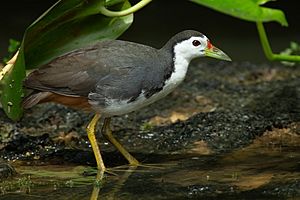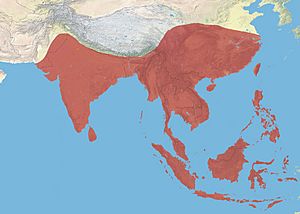White-breasted waterhen facts for kids
Quick facts for kids White-breasted waterhen |
|
|---|---|
 |
|
| Adult in Singapore | |
| Conservation status | |
| Scientific classification | |
| Genus: |
Amaurornis
|
| Species: |
phoenicurus
|
 |
|
| approximate range | |
| Synonyms | |
|
Erythra phoenicura |
|
The white-breasted waterhen (Amaurornis phoenicurus) is a shy waterbird. It belongs to the rail and crake family, called Rallidae. You can find this bird widely across South and Southeast Asia.
Contents
Meet the White-breasted Waterhen
The white-breasted waterhen is a medium-sized bird. It has a striking look with a bright white face and chest. Its back and wings are dark, usually a slate-grey or black color. The lower belly and tail area are a rusty red or chestnut color. These birds are about 32 centimeters (13 inches) long. They have strong legs and long toes. These features help them walk easily on floating plants.
What Do They Look Like?
Young waterhens look a bit different from adults. They have less white on their front. Their colors are also duller. This helps them blend in and stay safe. Both male and female waterhens look similar. It can be hard to tell them apart just by looking.
Where Do They Live?
White-breasted waterhens love wetlands. They live in places like marshes, swamps, and rice fields. You can also find them near ponds, lakes, and even ditches. They prefer areas with lots of thick plants. These plants give them cover and a safe place to hide. They are found in many countries. These include India, China, and Indonesia.
What Do They Eat?
These waterhens are omnivores. This means they eat both plants and animals. Their diet includes insects, worms, and small fish. They also eat seeds, roots, and shoots of water plants. They use their long beaks to search for food in the mud and shallow water. They are often seen foraging at the edges of water bodies.
Life and Behavior
White-breasted waterhens are mostly active at dawn and dusk. They are quite shy birds. They often hide among the plants. You might hear their loud calls more often than you see them. Their calls are a series of sharp, repeated notes. They use these calls to communicate with each other.
Family Life: Nests and Chicks
The breeding season for these birds varies. It depends on where they live. It usually happens during the rainy season. This is when food is plentiful. They build their nests close to water. Nests are often hidden in thick vegetation. They are made from reeds, grass, and leaves.
A female waterhen lays about 4 to 8 eggs. The eggs are usually pale cream or buff. They have reddish-brown spots. Both parents take turns sitting on the eggs. This is called incubation. It lasts for about 20 days. Once the chicks hatch, they are covered in black down. They can leave the nest soon after hatching. Both parents help feed and protect the young.
How They Stay Safe
Because they are shy, white-breasted waterhens are good at hiding. When they feel threatened, they quickly disappear into the dense plants. They can also run very fast. They use their strong legs to move quickly through the undergrowth. This helps them escape from predators.
Conservation Status
The white-breasted waterhen is a common bird. Its population is stable. The International Union for Conservation of Nature (IUCN) lists it as "Least Concern." This means it is not currently at risk of disappearing. However, their habitats are sometimes threatened. This can happen due to pollution or land development. Protecting wetlands is important for these birds.
Images for kids
See also
 In Spanish: Gallineta pechiblanca para niños
In Spanish: Gallineta pechiblanca para niños





